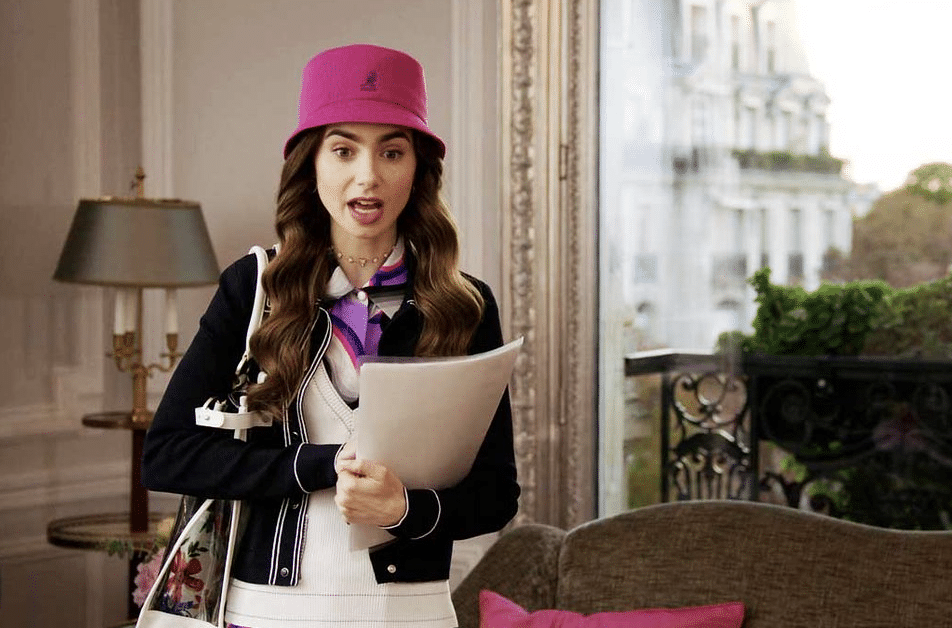My not-so-professional review of the Netflix original, Emily in Paris
By: Madeline Stephens | Staff Writer
I remember when this promising series was first released on Netflix. I was ecstatic and of course started watching the second I could. The show’s title includes Paris, so I anticipated being engulfed in a storm of authentic French culture. My expectations were high, no doubt, but my excitement quickly vanished nearly five minutes into viewing. After barely surviving the first season, which I finished over two years ago, I felt as if I needed to take a break to detox if you will—and detox I did. What can I say, the show was disappointing and did not satisfy my French fix. Upon hearing the news of season three’s release, I contemplated whether or not I should give the two most recent season’s a chance at redemption. Steadfast in my willingness and determination to persevere through the overdramatized plot and mockery of French culture, I watched the show.
Emily—The American that Chased her Dream across the Big Pond
Emily, the dumb American. No, seriously, her mannerisms, especially toward the beginning of the show, emphasize her lack of common sense and almost an intended air of cluelessness. While Emily plays the happy-go-lucky, confident, and “curious” American girl in Paris, everyone around her plays into her character by showing pity—pity that she is not asking for, but a pity that is well-deserved. She is beyond ignorant at the onset of the show and truthfully, throughout. My grand issue here is as follows: Emily shows up on the scene with the intent to put her coworkers at Savoir in their place, to teach them something about the American work ethic. No one in their right mind would strut into a workplace like the one presented in the show with this selfish intent that Emily carries. Unfortunately, I don’t think Emily is ever “put in her place” and continues to climb the ladder—lying, talking over others, claiming that she is a social media superstar—while leaving others either a. no room to talk, or b. mislead and cheated. Simply put, I believe that while Paris is capable of handling Emily, Emily cannot–and in the upcoming seasons, will continue to be incapable of wholly handling Paris.
Sophisticated Sylvie and Why She’s Not French
Sylvie- A reimagined, watered-down Miranda Priestly, a stone-cold, French woman who has no soul or capability to be sympathetic or empathetic, and only lives to work. This is where a lot of French citizens drew the line and often took offense to the show’s narrative. Sylvie’s character speaks to French stereotypes that many regard as true but are genuinely faulty. Sylvie plays the boss that will crush those who do not obey her as if they were pesky insects. French people do not bite like Sylvie seems to, and they actually have a better work-life balance than Americans. Emily in Paris does everything to negate this, painting Sylvie to be a working machine that must sneak around to fulfill her desires such as love, outside of the workplace. Sylvie should not and does not represent the French citizenry, but due to her large role in the show and her interactions with those in fashion’s hierarchal world, the viewers see her at the forefront, playing the role of French businesswoman.

The Not-So-Elegant Emily: Emily’s Take on Fashion in Paris
I understand that the producers were attempting to highlight Emily’s rather bold personality by dressing her with vivid colors and outlandish patterns, but in some instances, I was left speechless as I watched her prance across the screen. Paris is renowned as one of the world’s fashion capitals, but the excessive presence of mismatched outfits did not do justice to Emily’s hankering to elevate her sense of fashion in her new environment. If anything, her choice of outfit accentuates the American naivety that her character brings to the table. Granted some styles of hers do communicate a Parisian, modern-chic-esque look, but those outfits are few and far between. Poor Emily is not in touch with the French style and rather embodies—as one staff writer for Vogue described her attire—a kaleidoscopic jumbo puzzle. Too much all at once.
All English, A lot of American, Very Little French, All in France
Isn’t it crazy how everyone Emily is in touch with speaks near-perfect English? Even Sylvie, when speaking English, barely has a French accent. Well, even in the business world, real-life Emily would be bound to stumble across situations in which others around her struggled to speak English. Something else that caught my attention in the show was the sporadic inclusion of French dialogue as if to tease the viewer with the taste of French culture. Come on, speak more French! You’re in France! Don’t even get me started on Emily, yet again, playing dumb American, butchering the language in a seemingly intentional manner. The same goes for the character Madeline when she comes to France. In some instances, both Emily and Madeline spoke clear, conversational French, and in other moments, they nearly mocked the language. Pick a side…
The City of TOO MUCH Love
Oh, how love and lust muddy the plot of the show. If only I could see past Emily’s ability to so feverishly avoir le coup de foudre, maybe I could find some deeper meaning, some effective theme behind the story. Unfortunately, that is not the case. The love triangle, or rather the love hexagon—affairs, lasting feelings, regret, lies, one-night stands—simply defines the plot of the show. How cliché, almost like every other aspect of the Netflix original. Trust me, I know that a steamy romance has the power to make or break the perimeters of a show, but Emily, Sylvie, Camille, Mindy…oh the drama, the secrets, the lies. How do these women time for anything but the sort, especially their rather high demanding careers? I guarantee that Paris is truly as romantic as it claims to be, but maybe—just maybe—tone it down a notch? Love is surely not what the city is all about, after all, right?
Final Thoughts
Well, there you have it. Emily in Paris, while it may be a show full of clichés, reportedly offensive portrayals of French and American stereotypes, and the term fashion capital turned over and upside down, is nonetheless semi-amusing. Maybe if I had viewed it with a less harsh, critical eye, I would have had less to say, far less to critique…so thankfully, my eyes were in check, because viewing this show in all of its messed-up glory was well worth it. Don’t just take my word for it. Head over to Netflix, grab some store-bought eclairs or madeleines and give the show a go. It’ll give you a good laugh, cringe, cry, or two.
Photo from Flickr













